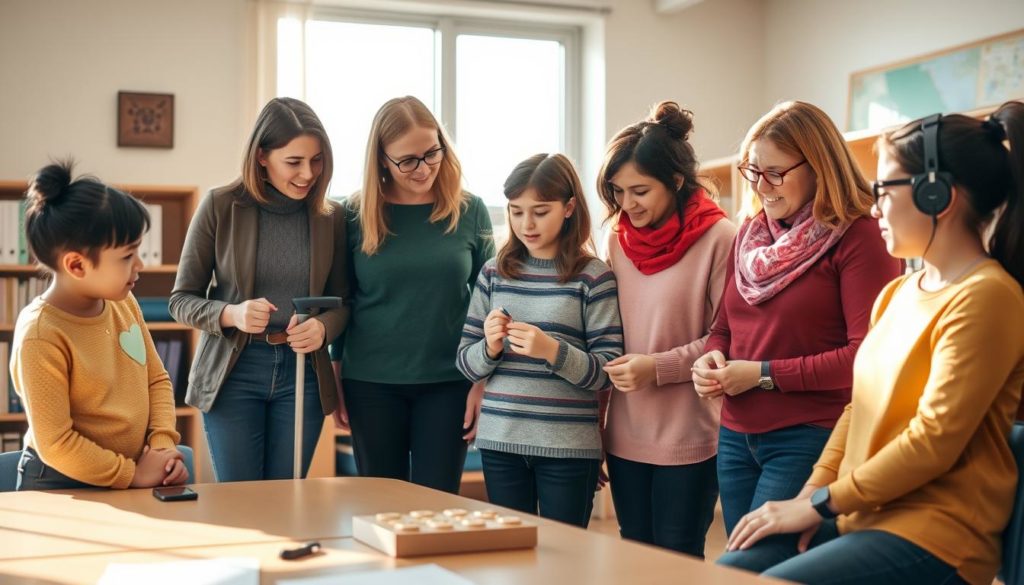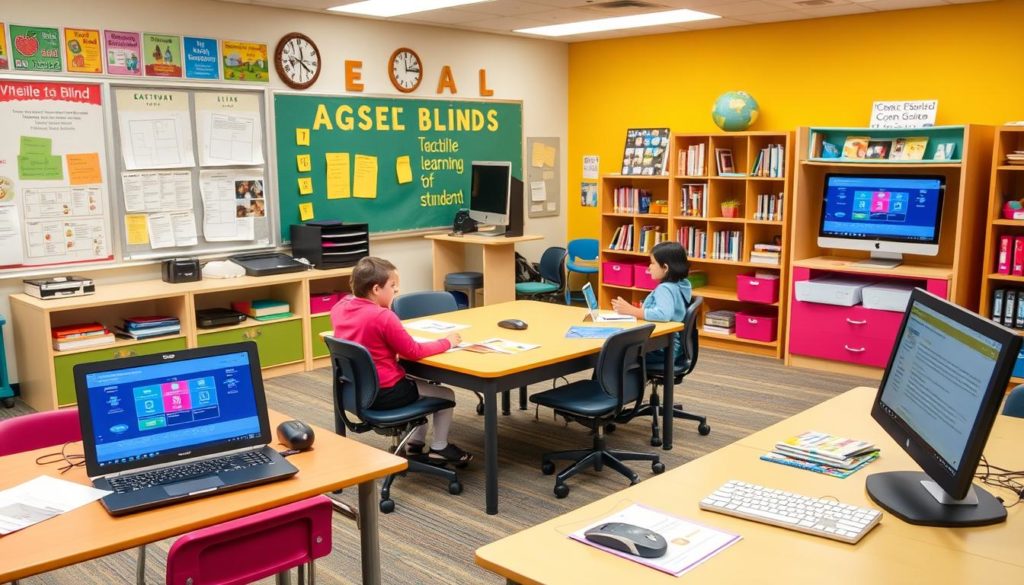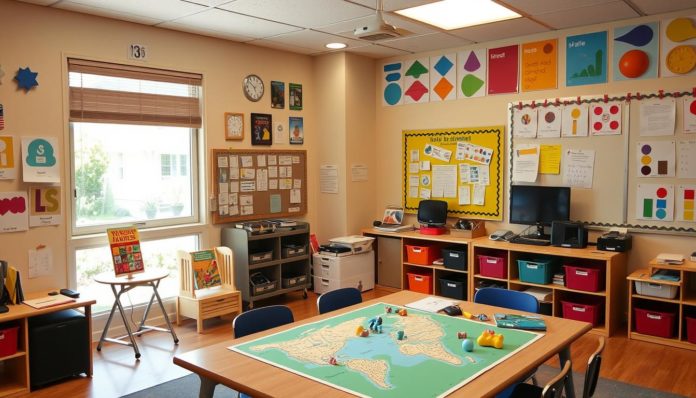Did you know over 70% of students with visual impairments need help daily from paraprofessionals? This fact shows how important these helpers are in schools. They make a big difference in the education of visually impaired students. This guide will explain why their work matters so much for a fairer learning place.
Paraprofessionals do so much, like setting up special tech and tailoring activities for each student. They are the hidden champions making sure every student gets what they need. Let’s find out how these amazing people change lives. They show us the best ways to help and understand blind students.
Understanding the Role of Paraprofessionals for Blind Students
In the realm of special education, paraprofessionals for blind students play a critical role. They help close the gap between standard education and the needs of visually impaired students. This ensures a learning environment that includes everyone and works better.
Definition and Importance
Paraprofessionals are helpers in education who support teachers and students. For blind students, they are very important. They help make learning materials accessible, support independence, and help students fully participate in their classes.

Key Responsibilities
The educational roles of paraprofessionals for blind students vary widely. Some of their main duties include:
- Adapting classroom materials to braille or large print
- Providing one-on-one instruction and support
- Assisting with the use of assistive technology
- Facilitating communication between the student, teachers, and peers
Daily Activities and Support
Every day, paraprofessionals perform many tasks to offer student support. These tasks include:
- Accompanying students to classes and helping with note-taking
- Helping students move around the school
- Offering specific support during tests and assessments
Their commitment and expertise greatly enhance the educational experiences of blind students. They promote access and education for everyone.
Assistive Technology Integration in Blind Student Education
Assistive technology has made learning easier and inclusive for blind students. By using adaptive devices, these students get better support and can reach their academic goals on their own.
Types of Assistive Technology
Several assistive technologies are crucial for the education of blind students. These tools include:
- Screen readers: Programs that turn text into speech, making it easier for students to go through digital content.
- Braille notetakers: They are portable and help in reading and writing Braille.
- Audio textbooks: Allow students to listen to their study materials, helping them stay on track with their classes.

Implementation Strategies
It’s vital to have good strategies for using assistive technology in class. Some strategies are:
- Teacher Training: Teachers need training to effectively integrate and use these technologies.
- Customized Learning Plans: Education plans should be adapted to each visually impaired student’s needs for the best results.
- Regular Updates: Updating the devices with new software ensures they work well and are easy to use.
Benefits to Students
Using assistive technology helps blind students greatly. They do better academically and become more independent. Some key benefits are:
| Benefit | Description |
|---|---|
| Increased Independence | Students can get to their materials and finish work without needing a lot of help. |
| Equal Participation | This makes sure blind students can join in fully on class discussions and activities. |
| Enhanced Learning Efficiency | Adaptive devices make learning smoother, helping students keep up with their classmates. |
Educational Support for Visually Impaired Students
Paraprofessionals are key in helping visually impaired students. They create individualized education programs (IEPs) for each student. These programs make sure students get the unique help they need. They use special learning strategies to overcome challenges and improve learning.
Empowering students is also critical. Paraprofessionals teach them to be confident and self-reliant. By using customized learning strategies, students connect better with their lessons. This encourages both academic success and personal growth.
Let’s dive into the role of paraprofessionals:
| Support Aspect | Details | Impact |
|---|---|---|
| Individualized Education Programs (IEPs) | Creating customized plans to meet each student’s unique needs. | Enhances tailored learning experiences ensuring no student is left behind. |
| Learning Strategies | Implementation of specific methods and tools for better understanding. | Improves comprehension and retention rates of academic content. |
| Student Empowerment | Encourages self-reliance and confidence through skill-building activities. | Generates a sense of independence and confidence across different educational activities. |
Paraprofessionals play a huge part in this process. Their work is vital for the success of visually impaired students. With the right individualized education programs, they ensure everyone can achieve. They make learning strategies work and keep students empowered.
Inclusive Education Services for Blind Students
Making schools welcoming for blind students is key. By delivering full services and working together, these students do well.
Developing Inclusive Classrooms
Inclusive classrooms meet everyone’s needs, including blind students. There are several ways to do this:
- Adaptive Teaching Methods: Using different ways to teach that fit various ways of learning.
- Classroom Modifications: Changing the room so it’s easy and comfortable for blind students to use.
These steps create a place where blind students feel supported. They can join in with everyone else.
Collaboration with Teachers
Teachers working together is vital for including blind students. By joining forces, teachers and aides can do a lot:
- Share Insights: Talk about what students need and how they are doing.
- Co-Develop Plans: Make customized plans that fit each student’s own needs.
- Continuous Training: Keep learning about new ways to help students.
This teamwork builds a strong education system. It helps blind students get great support all around.
Let’s look at some key strategies for inclusive classrooms:
| Strategy | Benefits |
|---|---|
| Adaptive Teaching Methods | Makes learning work for each student’s style |
| Classroom Modifications | Makes sure everyone can get around and feel comfy |
| Teacher Collaboration | Brings teachers together to support personalized learning |
These services are crucial. They make sure blind students get a well-rounded and supportive education.
Specialized Training for Paraprofessionals
Paraprofessionals working with blind students need specialized training. This training helps them meet the strict professional standards required. It prepares them well for educational settings.
Training for paraprofessionals covers various important skills. These skills are vital for supporting students effectively. Let’s look at the key areas of training:
- Orientation and Mobility Skills: Teaching how to guide students through their surroundings safely.
- Assistive Technology: Gaining skills in special devices and software for visually impaired students.
- Communication Techniques: Learning the best ways to talk and listen to blind students.
- Understanding Braille: Knowing how to read and write in Braille to aid in literacy.
- Behavioral Support: Figuring out how to help students behave properly and interact with others.
These training programs are very important. They not only ensure professional standards but also give paraprofessionals the tools to improve blind students’ learning experiences.
| Training Component | Purpose |
|---|---|
| Orientation and Mobility | Helps students move around safely |
| Assistive Technology | Makes learning better with special tools |
| Communication Techniques | Makes talking with students more effective |
| Braille Literacy | Helps with reading and writing support |
| Behavioral Support | Helps students act appropriately |
Focusing on critical aspects of paraprofessional training leads to well-rounded skill development. It meets the demanding professional standards of today’s schools.
Best Practices for Paraprofessionals in Blind Education
Helping blind students learn well requires understanding key methods. This path has hurdles but also rewarding times. Success needs great communication techniques and good educational resources.
Effective Communication Techniques
It’s crucial to communicate clearly. Here are effective strategies for teaching:
- Verbal Clarity: Use clear and detailed language to share ideas.
- Active Listening: Give time to listen, making sure the student feels valued.
- Consistent Cues: Apply touch and sound cues in a regular manner to help learning.
These methods help in better conversations. They create a learning space that’s supportive and motivating.
Tools and Resources
It’s important for paraprofessionals to have the right tools and materials. With the correct assistive devices and training, they can offer great support to blind students.
| Tool/Resource | Description | Benefits |
|---|---|---|
| Screen Readers | Software that reads text aloud | Improves access to digital content |
| Braille Devices | Tools for reading and writing Braille | Enhances literacy and writing skills |
| Orientation and Mobility Training | Teaches safe navigation skills | Boosts confidence and independence |
Using these tools and methods, paraprofessionals can really make a difference. They promote better in-class communication and use helpful education resources.
Accessibility Services for Blind Students
Blind students get crucial help from accessibility services. This ensures they learn in an inclusive, effective way. By customizing support and assessing needs carefully, services meet each student’s unique requirements.
Identifying Student Needs
Understanding what blind students need begins with a detailed needs assessment. It’s a team effort with students, parents, and teachers. Together, they pinpoint the challenges and goals each student has. This assessment looks at academic, social, and physical needs in school.
- Collaborate with students and families
- Evaluate academic and social needs
- Review physical accessibility in the classroom
Providing Customized Support
Once the assessment is done, tailored support can start. This support is based on what each student specifically needs. It might be unique teaching methods, helpful technology, or changes to the classroom. The goal is for every student to reach their educational aims despite hurdles.
- Implement personalized teaching strategies.
- Utilize assistive technology effectively.
- Modify classroom materials and environments as needed.
| Support Type | Description | Examples |
|---|---|---|
| Assistive Technology | Tools and devices designed to aid visually impaired students. | Screen readers, Braille displays |
| Personalized Teaching | Customized instructional methods based on student’s needs. | Adapted lesson plans, one-on-one sessions |
| Accessibility Modifications | Adjustments to the physical and learning environment. | Enhanced lighting, tactile indicators |
Collaborating with Teachers in Blind Education
Working together is key for teachers and paraprofessionals in blind education. They need to combine efforts to help blind students succeed. Interdisciplinary collaboration is critical. It makes education better and helps include everyone.
Teachers and paraprofessionals should talk often. They need to share ideas that address blind students’ special needs. This teamwork builds trust and aligns their goals for education.
Working together means having regular meetings and planning lessons together. It also includes solving problems as a team. This way, everyone works as one to include all students in the classroom.
Success in teamwork comes from:
- Effective Communication
- Mutual Respect
- Shared Goals
Teachers and paraprofessionals have roles that fit together perfectly. By understanding this, they can both support blind students’ complete growth. Interdisciplinary collaboration is fundamental. It benefits students and the whole school community.
Professional Development for Paraprofessionals in Visual Impairment
In the education field, learning never stops, especially for paraprofessionals focused on visual impairment. They must keep growing and learning. This helps them support blind students better. They learn about new tools, resources, and research that help in their jobs.
Paraprofessionals can grow by attending workshops and taking special courses. Joining groups like the National Federation of the Blind is also helpful. These activities offer new ideas and information about laws and new devices. They also help paraprofessionals meet experts and make friends in their field.
When paraprofessionals focus on learning more, they help blind students more. They can make learning better suited for each student’s needs. This helps students in school and in life. It ensures all blind students get the education they deserve.
FAQ
What is the role of a paraprofessional for blind students?
Paraprofessionals help blind students by giving them custom educational support. They adapt teaching materials and help students use assistive tech. This makes learning better for students and helps them feel included.
How does assistive technology integration benefit visually impaired students?
Assistive tech, like screen readers, lets visually impaired students use educational materials on their own. They can join in class activities and do better in school.
What are some daily activities performed by paraprofessionals for blind students?
Paraprofessionals help with class activities and give one-on-one support. They assist with getting around and using tech. This ensures students can join in fully.
How do paraprofessionals collaborate with teachers in blind education?
Paraprofessionals and teachers work together to make lessons accessible. They come up with ways to include everyone, share updates on how students are doing, and meet educational needs.
What types of assistive technology are commonly used with blind students?
Blind students often use tech like screen readers and Braille displays. Also, audio books, magnifiers, and voice recognition help them learn better.
What specialized training do paraprofessionals need to support blind students?
They need to know Braille, use assistive tech, and help with getting around. Training in inclusive teaching and good communication is also important.
How do paraprofessionals contribute to individualized education programs (IEPs)?
They share ideas about what each student needs. They also help make and do learning plans, and keep track of how students are doing. This makes sure IEP goals are reached.
What best practices should paraprofessionals follow?
They should communicate well, stay up to date with teaching tools, work with other staff, and always look to learn more. This helps them do a great job.
What accessibility services are available for blind students?
Blind students can get special teaching materials, assistive tech, learning plans just for them, and learning how to get around. These services meet their unique needs.
Why is ongoing professional development important for paraprofessionals?
It keeps them informed about new ways to help blind students learn. This improves their skills and the support they give to students.
How can schools ensure an inclusive education environment for blind students?
Schools can make sure everyone is included by using adaptive teaching, changing classrooms, using assistive tech, and helping teachers and paraprofessionals work together well.


